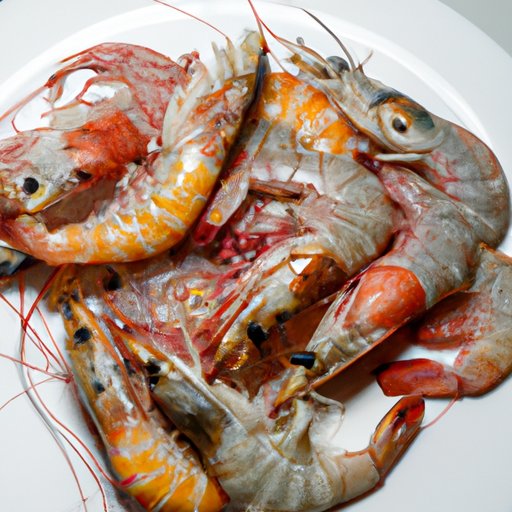
Introduction
Have you ever been served shrimp with their shells still intact and wondered if you could eat them? It’s not an uncommon question, and the answer may surprise you. While some people discard the shells, others consider them a delicacy and claim they offer health benefits. This article serves as a comprehensive guide to whether or not you can eat shrimp shells, potential benefits and risks of doing so, and how to properly consume them.
The Surprising Truth about Shrimp Shells: Are They Edible?
As a seafood, shrimp has been consumed throughout history, and cultures worldwide have prepared it in a variety of ways. What may surprise you is that in some cultures, the practice of eating shrimp shells has been around for centuries. In parts of Asia, for example, the shells are believed to have medicinal properties and are consumed for different ailments.
Another reason why some people eat shrimp shells is because they find them to have a unique flavor and texture. With a little bit of preparation, you can add a crispy and savory crunch to any shrimp dish.
Additionally, some research suggests that consuming shrimp shells may offer health benefits. Shrimp shells are rich in chitin, a compound known for its anti-inflammatory properties. Chitin can also aid in digestion and support gut health. Shrimp shells have also been linked to a lower risk of developing certain types of cancer and may help to strengthen the immune system.
To Eat or Not to Eat: A Comprehensive Guide to Shrimp Shells
Before you consider consuming shrimp shells, it’s essential to consider a few factors, such as their preparation method, origin, and potential risks. One common myth about shrimp shells is that they are dirty or contaminated. However, when responsibly sourced and cooked correctly, shrimp can be perfectly safe to eat, including the shells.
On the other hand, it’s essential to consider potential risks, such as allergic reactions. Some people may be allergic to shellfish, and consuming shrimp shells can trigger a severe allergic reaction. If you’re unsure about whether or not you have a shellfish allergy, it’s best to avoid eating shrimp shells.
Savoring Every Part of the Shrimp: How to Properly Consume Shrimp Shells
If you decide to consume shrimp shells, it’s essential to prepare and cook them correctly to avoid any potential risks. Shrimp shells are commonly used to flavor broths and soups by simmering them for hours or even days. You can also bake, fry, or grill shrimp shells for a crispy and savory snack or add them to stir-fries and other dishes.
Before cooking the shells, ensure they are thoroughly cleaned and deveined. You can do this at home by removing the legs and head and then using scissors to cut along the back of the shell and remove the digestive tract.
When consuming shrimp shells, it’s important to remember that they are tough and fibrous, so it’s best to chew them thoroughly before swallowing. If you’re not used to the texture, it may take some time to adjust.
Shrimp Shells: A Nutritious Addition to Your Next Meal?
Shrimp shells are surprisingly nutritious and can be an excellent addition to a balanced diet. Shrimp shells are high in protein, fiber, and minerals such as calcium and magnesium. They are also low in calories and fat, making them a perfect snack or topping for salads and other dishes.
While shrimp itself is a good source of protein, consuming the shells can add an extra nutrient boost to your meal. They can also be a more sustainable and cost-effective way to consume seafood, as it reduces waste and utilizes every part of the shrimp.
Waste Not, Want Not: Exploring the Validity of Eating Shrimp Shells
In addition to providing potential health benefits and nutritional value, eating shrimp shells can also be an environmentally friendly practice. In many parts of the world, seafood waste is a significant problem, and the shells are often discarded, causing harm to the environment. By consuming shrimp shells, we can reduce waste and utilize every part of the shrimp.
Furthermore, by consuming the shells, we can also promote sustainable and responsible fishing practices. Shrimp is a popular seafood, and overfishing can be detrimental to the environment and marine life. By consuming shrimp shells, we can support the sustainable use of seafood and promote a more ethical way of consuming seafood.
Conclusion
While eating shrimp shells may not be a common practice in all cultures, it’s a trend that is gaining popularity and offers potential health benefits and environmental advantages. As with any food, it’s essential to consider preparation methods, origin, and potential allergies before consuming shrimp shells. However, when cooked correctly, they can provide a flavorful and nutritious addition to any meal.
If you’re looking to try consuming shrimp shells for the first time, remember to start slowly and work up to incorporating them into your diet. With a little bit of preparation and practice, you may find a new and exciting addition to your favorite shrimp dishes.





